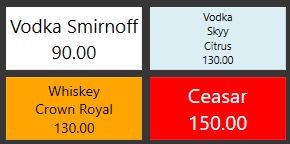Script to set the Header to contain the Price for the default Portion:
UPDATE mi SET [Header]= REPLACE(mi.[Name],'\r','<br/>') + '<br/>' + convert(varchar(50),p.[Price])
FROM [ScreenMenuItems] mi
JOIN [MenuItems] pr on pr.[Id] = mi.[MenuItemId]
JOIN [MenuItemPortions] po on po.[MenuItemId] = pr.[Id] and po.[Id]=(SELECT min(po2.[Id]) FROM [MenuItemPortions] po2 WHERE po2.[MenuItemId]=pr.[Id])
JOIN [MenuItemPrices] p on p.[MenuItemPortionId] = po.[Id]
Result:
